Even though people often assert (rather lazily) that the Voynich Manuscript is the only artefact ‘of its kind’, this is false, because there are plenty of similar documents. For the most part, the significant difference is merely one of scale, not of type – for example, the similar enciphered Quattrocento documents that do exist are neither as well-encrypted nor as large as the VMs.
The critical concept here is, of course, similarity: for Art History is a discipline built around discerning similarities between artefacts not just in terms of content [i.e. that-which-is-being-represented], but also in terms of style, gesture, technique, and approach (though, as Charles Hope points out, this falls over when art historians reconstruct an underlying linking mythology that wasn’t originally there). So, putting our art historian hats on, what are the best matches for the Voynich Manuscript?
Of the various Quattrocento enciphered manuscripts, the ones that really leap out are the books of secrets by Giovanni Fontana, for which the best edition by far is Battisti and Battisti’s (1984) “Le Macchine Cifrate di Giovanni Fontana”. This includes Latin decipherments of the passages in (simple monoalphabetic) cipher, together with a parallel translation into precise modern Italian. My Italian comprehension remains only middling, so making a suitably careful reading of this remains more of a long-term project for me than a short-term one.
Fontana’s manuscripts trace a merry criss-cross pattern across the map of my research interests: ciphers, fountains, alchemy, cars, weapons, and even optics. For the last of these, it was interesting to see folio 70r of Fontana’s Bellicorum Instrumentorum Liber reproduced by Sven Dupre in a recent paper: the Latin plaintext says “Apparentia nocturna ad terrorem videntium“, while the Latin ciphertext reads “Habes modum cum lanterna quam propriis oculis[ocolis] vidi<i>sti ex mea manu fabricatam et proprio ingenio“.
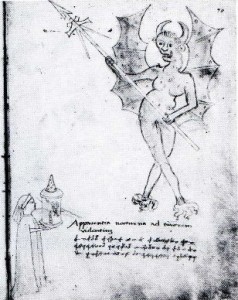
Bellicorum Instrumentorum Liber, folio 70r
Also optically interesting are the mirrors on folio 41v “Speculum ingeniosum et admirabile, cuius una pars super alteram ducitur, et clauditur quando opport<et>. Et ex calibe fit ad formam hanc cum foraminibus incident<i>e radiorum, Ymagines aparent deformes, turtuose, inequales, ambigue. Sed eius compositio hic aliter non describitur, nisi sub brevita<te>, ita ut me intelligas. Pars comcava fit sicud specculum combustivum archimed[ni]dis, convexa vero sicud speculum meum de multiplicate formarum.”
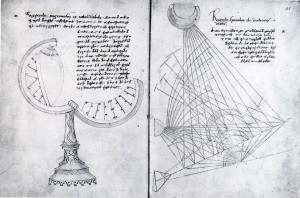
Bellicorum Instrumentorum Liber, folios 41v and 42r
But I suspect that it is Voynich researchers who will have most to gain from Battista & Battista’s wide-ranging scholarship. For sheer similarity with the balneological / water section, few would surely disagree with the nymphs bathing in the “Fons Virginum” on folio 43v, with the fountain on folio 31r, and particularly with the “Fons Venetus” (also with a water nymph!) on folios 22v and 23r. [Note to self: remember to get a copy of Frank D. Prager’s “Fontana on Fountains“, Physis XIII, 4, 1971, p.347.]
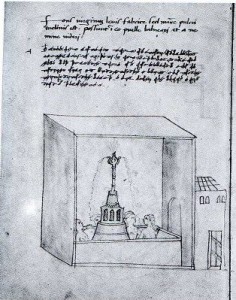
Bellicorum Instrumentorum Liber, folio 43v
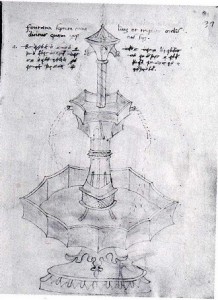
Bellicorum Instrumentorum Liber, folio 31r
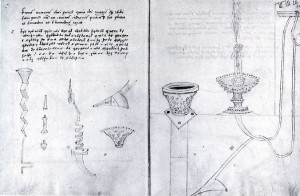
Bellicorum Instrumentorum Liber, folios 22v and 23r
As with the VMs, even though some adjacent folios are definitely in the correct order (such as folios 59v and 60r), I do wonder whether the page order has at least been partially scrambled: to my eyes, the rocket-powered roller-skateboard on folio 16v really ought to sit opposite the rabbit on a rocket-powered roller-skateboard on folio 37r (my favourite Fontana drawing!)
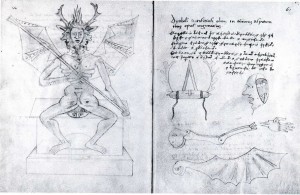
Bellicorum Instrumentorum Liber, folios 59v and 60r
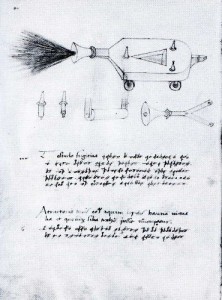
Bellicorum Instrumentorum Liber, folio 16v

Bellicorum Instrumentorum Liber, folio 37r
In short, there are plenty of similarities between Fontana’s enciphered book of secrets and the Voynich Manuscript: the key difference between the two is simply that heavyweight art historians take the former seriously, but the latter cum grano salis.
What I’m trying to do (in my own slow way) is to construct a proper art historical account of the VMs – a Battista & Battista for the VMs, if you like. However, with only Rene Zandbergen’s site and D’Imperio’s “An Elegant Enigma” to rely upon, this is really quite a daunting challenge, particularly because (as the absence of reaction to my first book would seem to imply) even Voynich researchers appear not to be interested in this kind of research programme. Perhaps because this looks too much like hard work?
I would even go so far as to say that anyone interested in the art history of the VMs should buy a copy of Battista & Battista’s book, simply because of the wealth of notes and thoughts embedded throughout it, nearly all focused on the right kind of areas. There are a few non-stratospherically-priced copies on BookFinder… so what are you waiting for? 🙂
I would like any leads where I can read about Fontana’s work with self-propelled cars and gunpowedeer fuelled rocket sleds.
Grazie
Jim Fontana
[email protected]
Then you should buy yourself a copy of the book!
Whatever level your Italian, the pictures are largely self-explanatory! 🙂
Fascinating … what does “Habes modum cum lanterna quam propriis oculis[ocolis] vidisti ex mea manu fabricatam et proprio ingenio.” mean in English?
That last image almost seems out of place, although the costumes shown in the book alude to the demoness. Very strange in an engineering tome.
== John ==
Were the explosive qualities of magnesite known “way back when”? Also, which is the mineral that will burn when mixed with water (phosphorus?)
birds propel with wings?
rabbits propel with farts?
fish propel with fins?
Maybe all three animals were being considered as possible “weapons delivery systems”? Fish in the moat? Birds on the ramparts? Rabbits through the sally ports?
Seems to me that much of “engineering” development is spurred by weaponry research.
Who was the historical figure that created the mirror that destroyed a whole fleet of ships?
Is the person on f70r carrying a lantern? This is what Google’s Latin says, but I am not sure. This is the link to the manuscript at the BSB library
http://daten.digitale-sammlungen.de/0001/bsb00013084/images/index.html?fip=193.174.98.30&id=00013084&seite=1
Ellie: it’s a magic lantern (projector), which Fontana claims was able to project and magnify images.
However, there’s a lot of controversy over this, as most optics historians doubt that lenses made in Fontana’s time would have been able to produce anything like a nice clear projected image. Having said that, I suspect that if your aim was to produce something large, blurry and spooky, then perhaps 15th century optics would have been good enough, it’s hard to tell. 🙂
Nick, Ellie, Mr. Fontana,
My earlier commentary in re self-propelled “weapons delivery” was the result of my losing my way amongst Nick’s “telescope” pages. So, I notice that this morning’s discussion refers to a “magic lantern”.
At the risk of being a total bore, I am going to hearken to Fr. A. Kircher’s “Ars Magna Lucis”, p.768. My recollection may be faulty, but I don’t remember reading anywhere that Kircher ever claimed to be the inventor of the magic lantern.
bdid1dr 🙂
Novel use of carnivale costume.
Hi Nick,
Thanks for the great review.
Do you have a copy of this Battista & Battista book on Fontana handy? I’m interested to know if they offer decryptions and translations of all the text in the Bellicorum.
In particular, I’m interested in the text on pages 67v to 70r,
all the best,
MM
As a contemporary enciphered text to the Voynich, the Voynich author may have been familiar with it, though if you believe the carbon dating the Voynich may pre-date or have been written at precisely the same time as it.
A site looked at today says.
“he Giovanni Fontana Cipher, attributed (sic.) to the Italian engineer and writer Giovanni Fontana in the 15th century, is an early example of .. “homophonic substitution cipher.”
In this cipher, each letter of the plaintext is replaced with multiple symbols or characters, creating a one-to-many mapping. Unlike simple substitution ciphers, where each letter is replaced by a single corresponding letter, the Giovanni Fontana Cipher provides several possible alternatives for each letter, introducing ambiguity and complexity to the encrypted message.
Which is sort of what Newbold sensed, isn’t it? That maps to multiple alternatives was one reason he was ridiculed – apart from his microscopic-writing idea. Is it similar to Colorni’s later method(s)? I’ve always wondered if the Voynich cipher-key mightn’t be among those which Colorni recorded while writing his book about ciphers in Prague.
“…in our opinion, the code of the VMS, although apparently a substitution code, is in no way a simple one. It appears that alongside glyphs that can be exclusively mapped to one specific plaintext letter, such as ‘8’ → ר (resh) and ‘9’ → י (yodh) (provided we exclude the abbreviation ‘89’ for YHWH), we can find groups of glyphs which can be mapped to groups of plaintext letters. One such group is the position-dependent glyphs:
EVA-o , EVA-t,
which all map to ב (beth/vet) or וְ (waw). Additionally, as suggested above, a ‘c’ in a connected version can transmute the meaning to ב (beth/vet) or וְ (waw) when a curl is drawn above it or centrally above the connection line (then for both ‘c’s). This substitution into the letters ב (beth/vet) or וְ (waw) appears to be the most complex among those non-trivial substitutions/mappings…”
This position-depending, different appearance of semantically same letter is not an invention of the VMS-coders, it is native to some writing systems. Guess for which languages? We have it still in a “crippled” form in the language we use to utilise in this forum, but here only in one position – the first letter of a sentence or Eigenname.
Darius,
The difficulty is that any variation on Wilfrid’s “single-Latin-author-for-all-the-content” theory is bound to be proven wrong in the longer term.
Of course I accept the possibility that ‘Voynichese’ might be in a cipher first invented in the fourteenth or fifteenth centuries and even one first invented by a particular western Christian (a ‘Latin’).
It’s a reasonable argument (whether ultimately true or not) that the variety of hands is no more than a result of that author’s hiring several scribes. (In that case I’d loved to have heard the dictation. ) 🙂
But for one person to have ‘invented’ all the drawings would need more than a variety of illustrators; it would require the person to have multiple personalities and certain attributes normally accorded none but the divine.
When Nick said, in his post, that “heavyweight art historians” see “plenty of similarities” between Fontana’s work and the Voynich manuscript, I can only say that the term “art historian” is a bit like “scientist” – it sounds impressive, but requires the practitioner’s field to be specified.
Though never heavy and I’m fairly sure someone who would reject instantly any effort to call him an “art historian”, Philip Neal’s opinion is the one I’d endorse, viz.
“some – not all – of the diagrams … slightly resemble Voynich illustrations”.
http://philipneal.net/voynichsources/fontana_cipher_manuscripts/
Diane, I’m not committed about Giovanni Fontana at all.
Could be his homophonic substitution cipher ideas have been applied without his participation. However, what I like on him (and some other people I mentioned in different threads) is his connection to Venice. It’s speculation, but I think Venice played a bigger role in eastern Mediterranean region at that time than Genoa. Venice was a kind of last protector of Byzantium before 1453 as it was not more then Constantinople town itself. In 1430 Saloniki fell to the Turks. The years before Venice tried to defend Saloniki as even Byzantium gave up to do it. A lot of monasteries there around (from Athos down to Meteora) which were on constant threat to be destroyed. People, mobile property, scripts were transferred to Venice and northern Italy in these years…
You know how I interpret the “optical tools” – as vessels for the souls on their way to the heavenly kingdom to be transformed into new “astral” corpses -metamorphosis, an eastern Christian perception. Came these concrete images from one of these monasteries? From the “Holy monastery of the metamorphosis”? (🙂, a yoke, but you see the importance of this concept).
Darius,
The ‘Germany-Venice’ storyline is of fairly recent creation, and strikes me as mostly a workaround of the old Germanist theory to accommodate Nick’s research (which concluded the manuscript made in Milan/northern Italy and some containers in the leaf-and-root section Murano-glass), as well as attempting to re-work results of unnamed others’ findings over this past thirteen years . A substitution ploy, as it were, like taking out ‘Franciscan’ and inserting ‘Dominican’ or taking out Genoa-Majorca and substituting ‘Venice-Dalmatia’ and so on.
I’m sure that like so many of its earlier versions, this latest form for the Rudolfine-German-ist storyline will be taken up with enthusiasm as the only possible line for sensible people to adopt (it was the same with the seventeenth-century Prague alchemy version, etc.etc.), but like all its earlier versions it will lack balance, be focused on an inappropriate period and will have a very hard time explaining just how many of its ‘ideas’ first arose. Like identifying the ‘castle’ in the Voynich map as token for Constantinople-Pera before Constantinople’s fall..
Phrases like “at that time” have to be used with care.
I did spend about three years or so looking into, and writing up, research into the history and works of Palaeologan Byzantium, Trebizond and the Black Sea trade (as some may remember), and even read on the interest in what we’d call ‘magic’ in the Palaeogan court during the fourteenth and fifteenth centuries, since I wanted to resolve the question of ‘no life-like image of any living thing’ in the ms. (Though as ever, there are a couple of exceptions to that general truth in the Vms too).
I treated those topics in the context of movement in people, goods and information. but overall, when weighing Venice-Adriatic against Genoa-southwestern Mediterranean , with the evidence of interactions with Jews and with the sources for most Voynich plants, the balance of internal and external evidence proved heavily in favour of Genoese-Jewish co-operation in Constantinople-Pera as in Majorca, in the Black Sea, and within the Mongol domains having caused matter now in the Vms to be brought together in southern Europe, between c.1330- c.1350 before the present ms was made between 1405-1438 or, as per Panofsky’s assessment ‘1410-20-30’. I like to believe that whatever the popularity of an historical storyline, in the end the primary document’s testimony wins..
If that pointed to a post 1450 date, I’s be more inclined towards Venice but it doesn’t.
And that’s why I’ve so often spoken of the Avignon papacy and suggested that anyone with access to those archives might find useful scripts there. I’ve just heard on the grapevine someone took up that suggestion and found something useful. If true, that’s great news and I look forward to learning more.
Darius – about the containers – Newbold’s idea of neo-Platonic theories in the ms wasn’t a bad idea in itself, and his theory-driven approach to the drawings has proven the most common ever since.
(here ends the epistle)
Diane, your narrative is not that dramatically different. We see some reasons to assume the original came from East Mediterranean. You tend to the Genoa-Mallorca-Avignon connection in the second half of 14th, me to Venice-Rom connection first half of 15th century (15-30). It’s a compilation so two different channels are thinkable as well.
My fiction is Venetians brought it to Italy and passed it on to “their” Venetian pope Eugene. Eugene could not do anything with this heretical, gnostic gift and wanted to get rid of it. People from his chancery (interested intellectuals) persuaded him to make a coded copy, which no one non-initiate would be able to read (…for my sake, do it, but do it quick, comment every passage disrespectful so there is no doubt about our attitude, if someone in the future should… and make a cheap script without diligence as we don’t honour these words at all… and then burn the originals in plaintext).
I spent some time a while ago considering the pros and cons of Venice against Genoa. In Venice’s favour were such things as that Nick thought some of the vessels in the ‘leaf-and-root’ section were Murano glass, but in the end that didn’t quite fit te time-frame or the drawings.
another plus for Venice was proximity to Padua, if the ms had been about medicine (which it isn’t), and a couple of Venetians’ presence helping in the Byzantines in diplomatic negotiations between Mongols in the north, and Mamluk Egypt.
Also, one of the early Genoese cartographers removed to Venice, but all the relevant comparisons to details in the Voynich map are in charts that he made before that move.
Some herbals – notably the Udine, first noticed by a contributor to the Voynich mailing list – were not altogether unlike and proper to the Veneto.
But overall the balance of evidence was heavily in favour of the south-western Mediterranean, focusing on Genoa and Majorca (where Genoese were also residents during the 1330s-1350s and later, but no Venetians I could find. And of course Genoa’s links to Milan are relevant (because there’s a lot of good historical research in Nick’s book not directly his Averlino theory).
Bottom line is that Venetians just weren’t in the right places, at the right times, and didn’t produce any closely similar images. If the date-range for first arrival of the material had been 1460-1480, my conclusions might have been different, but in the end the manuscript has the final say, doesn’t it?
That’s how it is, Diane, and the manuscript has a lot to say. By the way, I see the Venetians in the role of the bringers of the original material for the MS. And here I don’t understand your assessment of why the 60-80s would speak in favor of Venice, but not the 20-30s. Before 1453 there was still a connection to Constantinople. The Venetians controlled this route. Venetian fleet brought John VIII Palaiologos to Italy in 1423 and again in 1448 where he met with Eugene and announced a formal union of the Eastern and Western Churches. Of course nullius momenti, but gifts were always exchanged and scholars were brought along. In 1416 and 1423-30 there were still Venetian victories at sea, which still left the routes to the eastern Mediterranean open. Later this will no longer be the case for years
Darius,
I think we take different angles of approach. My area being iconographic analysis, my approach is to take a given image apart (so to speak) and research each element in it, and then each drawing, and treating each drawing at first as a separate item of unknown origin. That done – and some of the drawings have taken days, others couple of weeks and the map almost three years’ research – I see what conclusions can be drawn about the various details in the various drawings and sections.
On that basis, I naturally don’t disagree that some sections reflect an older Greek influence, and am glad to see the ‘idea’ isn’t as startling now as it was in 2010. But that applies chiefly to the ‘ladies’ folios including the calendar’s tiers, though as I said when treating the map, its range is approximately that of the Hellemistic kingdoms. Not what remained of the Byzantine empire by the fourteenth century.
In the same way, it’s fairly obvious that I can’t disagree with mention of Constantinople, since I have said that Constantinople-Pera is the subject of that detail in the map, within a late-stratum roundel, and which Voynicheros term “the castle”.
Darius, what I’m trying to ask, but am concerned will come across as uncivil in the tone-less medium of type is what exactly are the points at which your theory connects to the manuscript’s materials, its forms (codicology), its written text or any of its drawings? I think I understand the story you want to tell, but cannot understand what leads you to think it’s the manuscript’s story.
Diane, I need to correct the following. I wrote about the Venetians as bringers of the MS, it should be called bringers of the compiled materials. sorry for the confusion. I see the materials as an collection of ancient, Gnostic and other texts. The material must therefore have been copied several times over the centuries. I think it is very unlikely that this could have happened within the sphere of influence of the Roman Church. That would have been known in my opinion. In my opinion, something like this would only have been possible under the egis of independent bishops of Orthodoxy. For the Roman Church it would also be a sacrilege not to destroy such texts; it would be contrary to church teachings since Irenaeus. The motifs that can be found in the texts (such as matamorphosis) are those of orthodoxy. which was probably willing to preserve those texts. Therefore my assessment
Darius,
Thank you for the clarification. You are fortunate to be introducing your theory now. Saying that the manuscript’s content was not the work of a single ‘author’ but a compilation from older matter, and much from non-Latin origins was met with guffaws and angry demands that I name the specific texts from which the matter had been gained. That you haven’t met that reaction is a very good thing; it shows that, though on leaden feet, this manuscript’s study as shown some forward movement over the past ten years.
I don’t know if you claim to read ‘Voynichese’ or endorse any of the claimed translations, but if not I suppose that your impressions of the content’s being gained from ancient and gnostic texts are your impressions some (all?) the manuscript’s drawings.
You may have noticed that none of the Voynich folios include interlace – the type of decoration so popular in older medieval manuscript art – Coptic and Irish, of English-, Armenian-, Islamic-, and Orthodox Greek. Do you think the absence of Byzantine motifs, including interlace, is a symptom of gnosticism – and if so, which brand of gnosticism had you in mind? Have you been able to compare any of the Voynich drawings with drawings in any gnostic texts? If so, I’d be very interested to read what you might have written in the way of a comparative analytical study.
I must admit that not sure what is implied by “independent Orthodox bishops” and could be glad if you could clarify.
Diane, I will write later about the other points. The „independence“ of the Orthodox bishops or metropolits comes from the structure of this Church, which doesn‘t have an own Pontifex maximus and therefore not a strict bound of instructions coming from a highest instance. This gives a bishop the possibility to decide in important quests without involvement of a collegium or a Roman Catholic-style Curia.
Darius – just to be clear – are you speaking of the modern situation, or that which existed before c.1440?
I hope I’m right in thinking that by ‘independent’ you mean the “autocephalous churches”, and I take your point that, unlike the situation in the western churches, the head of the Greek Orthodox church was regarded as no more than the most eminent bishop ‘among equals’.
Your idea seems to be that, within a given bishop’s jurisdiction, that bishop could do whatever he liked, including allowing ‘gnostic’ texts and so on, and then that these hypothetical(?) ‘gnostic texts’ were brought by John Palaeologus to Venice as – or within – the Voynich manuscript and possibly as a gift… to whom?
And why?
That is – what was it about the Voynich manuscript’s form, materials, written or pictorial elements which led you to conclude that the Vms is/contains gnostic material? What makes you think it looks like an imperial sort of gift volume?
Have you ever found some presented manuscript, from a Byzantine emperor, that has a similar appearance? (please tell me you’re not relying on a single drawing in a certain 9thC Byzantine ms).
The reason that so many have imagined the Voynich manuscript an amateur individual’s notebook is that, by contrast with products of most scriptoria and the products of later medieval ateliers, the Vms is distinctly ‘ratty’ looking. Second- or third- quality vellum, badly applied heavy pigment, pages of unequal size, the text-block untrimmed and so forth.
Even Newbold, who believed Wilfrid’s wonderful tale for the most part, baulked at the idea it would be something appropriately offered anyone of importance, and so imagined it rather a gift from Dee to Rudolf’s *gardener*.
So again, what in the Voynich manuscript itself looks ‘gnostic’ to you? How are you defining ‘gnostic’? And by what comparisons made to other manuscripts/texts/drawings/artefacts etc. were you led, in the first place, to form an idea that the Voynich manuscript contains texts or drawings made by a gnostic community or author(s)?
You might find some useful first references in the Stamford Encyclopaedia of Philosophy. Just one paragraph from one of its articles:
“The later Platonists shared an important commitment with orthodox Christianity, viz. to understand and explain the world in its entirety on the assumption of one principle only, not two principles that could be thought to be in opposition or conflict with one another (Gnosticism)”.
I don’t much sympathise with either position – i.e. the “one” or “two” – when it comes to attempting to understand Beinecke MS 408. The distinction I’ve observed as cultural influence in some of the Voynich drawings is not dualist but rather complementary opposites: the goat itself neutral, but tamed and untamed recognised. A similar principle – between ‘tame’ and ‘wild’ – is expressed fairly consistently by use of particular motifs in the plant-pictures. But there’s nothing about it to suggest the gnostics’ cosmic split between Deity and demiurge. No suggestion that one should having nothing to do with uncultivated plants.
So I keep coming back to the uncomfortable feeling that the whole ‘Venice-gnostic’ theory being developed by a sector of the Voynich community is just another artificial construction created in an effort to co-opt and to subvert, rather than to address and debate, information others have contributed but which is plainly unsupportive of the scarcely defined ‘central European’ storyline.
I really do hope I’m mistaken in think so, Darius, and this is why I keep asking for details of your research – the evidence and argument from that evidence which brought you to the opinions you’ve shared here.
Diane,
Hope you are well. Reading this I am actually kind of pleased, as an actually
thought you guys were onto something, because I was not clear to me what you
we’re talking about that you supposedly had. I guess if the MS is solved it
might be sad somehow, though usually it turns out there is often less than
meets the eye with any particular theory and evidence is wanting.
Levitov would be someone I guess you could point to who thought the MS was
somehow a Cathar document, and therefore Gnostic.
Looking at the thread that started this conversation was about Fontana,
and some contection to constructing fountains, in a city planning type way, I wondered about what the equivalent of the Masons was In Italy at the time.
Washington DC is built in a planned way with a few fountains with lots of Masonic influence, and a lot of astrology symbolism that is not clear to me. Are the Freemasons at all Gnostic? If so whatever their equivalents in Italy may have been as well. (Looking it up I see they are what’s called “gnostic-associated”, so not quite, or I am not sure). Though I too am waiting to see what Darius has.
Diane, Matt, there are so many aspects addressed in your posts that they cannot be covered all in a single post. Let me clarify two things here. I think that the independence of the Eastern Christian churches’ bishops from a highest instance instructions has existed for a long time, basically as long as these churches exist. This doesn‘t mean that they can do what they want.
I am aware that the term gnosticism is not clearly defined. Nag Hamadi Gospels are often referred to as Gnostic writings. As far as I know, the terms demiurge or emanation don’t even appear there. They originate more from the Neoplatonist and Aristotelian philosophical schools. But they are associated with Gnosticism as well. By the way, have you ever been to an Orthodox monastery, like the Meteora monasteries? How naturally Plato, Aristotle and Socrates are mixed in with the apostles is astonishing. In the images all seem to be Jesus’ younger…
Let me give you a very short, very simplistic, separating definition that doesn’t go into much detail. The central concept of Christian orthodoxy (in the sense of the main stream) is faith, while the central concept of gnosis is knowledge. Knowledge is God-given and God-created but not given to everyone. This perception of elitism in access of knowledge caused vehement resistance from the early Christian establishment (of the main stream church) and brought the Gnostics the accusation of secrecy.
In the most extreme form of anti-Gnosticism, it was even postulated that humans are incapable of new knowledge. This is roughly how I understand the term Christian gnosis.
So far this post. I’ll post something concrete from the vms in 2 weeks. I’m traveling at the moment but I have it on my laptop at home.
Darius
“How naturally Plato, Aristotle and Socrates are mixed in with the apostles is astonishing”.
Not really astonishing, given that Plato is to Greek orthodox theology more-or-less what Augustine was to Latin theology. And, if you’ll forgive my re-quoting material included in a post of my own (7th March 2022).
” …reading classical Greek and even composing in the same style were an integral part of Byzantine higher education. .. those who took their education beyond the age of fourteen would be instructed in the works of the ancient Greek poets, historians, dramatists and philosophers. Thus any educated Byzantine in the imperial service would have had a knowledge of these [ancient and classical] works which would have been the envy of many educated Italians.”
– Jonathan Harris, ‘Byzantines in Renaissance Italy’. (reference given in that post).
I do look forward to learning what it was about the Voynich manuscript that led you to conclude that it is partly or entirely gained from a gnostic text or three.
As I have written many times, in my opinion, it is a compilation of various texts, including those that represent a type of Gnostic preaching. But there are also other texts. The „Voynich map“ is in my my opinion an evolving apocalypse, 67v, 57v are not religious at all, 1r a rather historical page…
Darius,
No, I haven’t been, unless it was in a former life. Looks interesting though. Those monasteries are in a beautiful part of the world. I can see what you are getting at.
It would fit the St. Jerome/Illyrian concept that Kircher mentioned as well as far as a possible language. A couple things. One, we’re these folks at the monestaries performing any sort of scientific experimentation, as the central “hub” of the rosette page seems to have what we presume is a St. Marks or St. Basils type building on top of what looks like a giant microbe. The other, while I would agree as a believer, that grace (or punishment)comes ultimately from god, I guess I really don’t think the holy church has anywhere near a handle on ever scam or scheme out there…let alone every new idea. What did Donald Rumsfeld say about “Known unknowns”, and “unknown unknowns”. I have faith, though science has a way of progressing on its own without anybodies permission. The word Byzantine has been coming up in my world recently. There was a curious letter supposedly one, Prestor John I saw for the first time the other day. I had heard of him, though this thing… It is described as anti-Byzantine. Kind of a combination of More’s Utopia and Bacon’s New Atlantis which I imagine drew inspiration from it, but more grandiose, and a tad weird. When the Portuguese visited the East, and didn’t find much, they must have thought hmm. Like we all thought when we looked at the VMs.
Anyway, good luck on your endeavor.
Matt, there is much to write about the Gnostic view of religion. But I think I’ll devote myself to pure translation, without much exegesis. My effort will be to enable others to take part in the project by providing tools and assistance. It is an intellectual challenge with a high barrier to immerse yourself in an ancient language and world of thought. I hope the tools, and GPT will also play a role here, will help lower this threshold.